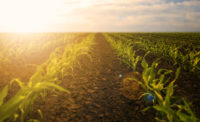Fiscalini Cheese Co. is a fourth-generation family farm based in Modesto, Calif. Since its inception, the cheesemaker has cared about sustainability, animal welfare and capture methane to power its facilities. It also strives to use fertilizer and irrigation efficiently on the dairy forage operation, and rotates corn, sudangrass and winter wheat to feed the herd. But, it turned to Ceres Imaging, Oakland, Calif., to identify irrigation issues during the corn season.
"We’ve taken soil samples in the past, and that works. But, when you take a soil sample, you’re going to the middle of the field for a representative area or pinpointing a specific area,” says Brian Fiscalini, general manager. “When you’re talking about a pretty large field, you’re only getting a snapshot of that place. With the aerial imagery you’re getting a much larger picture."
By employing aerial imagery, Fiscalini Cheese was able to:
- See why some fields were better or worse producers.
- Determine which fields needed re-leveling.
- Solve irrigation problems.
- Save upwards of $9,000.
Ceres Imaging uses aerial spectral imagery and neural networks to tell farmers which crops aren’t getting enough water or to detect pests and diseases before an outbreak can spread.
“Maintaining ideal irrigation levels is a huge challenge for farmers,” says Ashwin Madgavkar, chief executive officer of Ceres Imaging. "Overwatering results in the waste of a precious—and costly—resource. Underwatering lowers yields. Our technology helps farmers be strategic about how they use resources, so their operations can be both profitable and sustainable.”
“People may have in their minds that large farms are going out there and spraying chemicals on their crops without responsibility or intention. It couldn’t be further from the truth,” Fiscalini adds. “All farmers want to make safe, healthy food for people. That’s where this technology helps. You can pinpoint areas of the field, instead of treating the field as a whole.”









